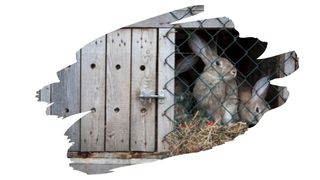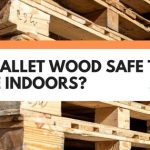If you are going to make a hutch, then it must be made from rabbit-safe material. End of.
But, when it comes to old pallet wood, you can’t be sure of what type of timber it’s been made from. Or even what kind of chemicals that pallet has been treated with.
So, what should you look for when it comes to checking exactly what has gone into pallet wood? And how can you also be sure it’s safe to use around your pet rabbit?
Well, in this post, you will find out what really goes into the manufacture of wooden pallets. You’ll also discover why even some heat-treated wooden pallets can still contain toxic chemicals.

This post may contain affiliate links to products that we receive a commission for (at no additional cost to you). Learn more here.
Can You Use Pallets For A Rabbit Hutch? (Or Are Wood Pallets Too Toxic?)
It mostly depends on how that wooden pallet has been treated — and what it’s been treated with.
You see, wood can have bugs, termites and insects in it, after it’s been milled. So, to get rid of those pests, wood needs to go through a treatment process.
OK…But What Does The Treatment Of Wood Have To Do With Pallet Toxicity?
Well, years ago, wooden pallets were put through a fumigation treatment in order to get rid of those bugs. And the substance used to disinfect those pallets was a toxic chemical called Methyl Bromide.
Now, Methyl Bromide is some very nasty stuff. If you inhale it, ingest it, or any of it gets on your skin, it can cause serious health issues.
Which is why wooden pallets that have been marked as ‘MB’ (Methyl Bromide) are much too toxic to have around. And they are certainly much too dangerous to use for a rabbit hutch.
However recently, the way wooden pallets have been treated has changed. And that change has made pallet wood much safer.
Related Post: Can You Really Use Untreated Oak For Raised Beds?
And What Types Of Wooden Pallets Are Safer To Use?
In the US, Canada and UK, pallets are more likely to be treated with heat, rather than Methyl Bromide.
These high-heated pallets are referred to as ‘heat-treated’ pallets. And they are heated to temperatures so hot, that it removes all insects that may be nestled in them.
You see, there are three main types of heat-treated wooden pallets:
- Heat Treated Pallets (Marked as ‘HT’)
These pallets are treated by placing them in a chamber, and baking them at temperatures of around 56°C (132.8°F) for over half an hour.
There are no fumigation chemicals involved here, which is why heat-treated pallets are safe — certainly much safer than any pallets disinfected with Methyl Bromide.
- Kiln Dried Pallets (Marked as ‘KD’)
Kiln Dried Pallets get put through pretty much the same process as HT pallets. Except, they are super heated in a kiln oven, instead of a chamber.
Another key difference is the temperature they’re heated up to (and for how long).
Kiln Dried Pallets get heated to a sweltering 94°C (201.2°F) for up to 36 hours. Which is certainly more than hot enough to get rid of any bugs still hanging about.
So, just like with HT pallets, KD pallets are safe to use.
- Debarked Pallets (Marked as ‘DB’)
Last, but not least, are Debarked Pallets. These pallets get put through the same heat-treatment process as HT pallets.
Except Debarked pallets will have had their tree bark removed before they get put through the heating process. The reason for removing the bark is simple; it makes it easier to heat up and dry out that timber.
And, once again, similarly to HT and KD pallets, debarked pallets are also safe for you to use.
So This Means I Can Make A Hutch From Any Pallet Marked HT, KD, or DB, Right?
Almost, but not quite.
While heat and fumigation do a great job at getting rid of insects, they do nothing to help stave off rot. So, if that pallet becomes damp with rainwater or humidity, wood rot can take hold. And sometimes bugs can even make their comeback as well.
Which is why wooden pallets often get put through a secondary treatment process, called pressure treatment.
And What Is ‘Pressure Treatment’?
Pressure treatments involve infusing wood with rot-resistant chemicals. The job of those chemicals is to act like a fungicide, and fight off wood rot bacteria.
However, those self-same wood preserving chemicals are made of some pretty toxic stuff too. For example, some pressure treatment wood preservatives — such as Chromated copper arsenate (CCA) — can even contain arsenic.
How Can You Tell If A Heat Treated Pallet Has Been Treated?
Pallet wood, (that’s been put through a pressure treatment), will have a stamp clearly indicating it’s treatment.
The two main stamps for pressure treated pallets, (from the US, UK, and Canada), are GC (Ground Contact) or PT (Pressure Treated).
So, if you’re using reclaimed heat treated pallet wood, make sure you check it carefully for those GC/PT stamps.
OK…So Are Heat Treated Pallets Safe Enough For A Rabbit Hutch?
Newly purchased heat treated pallets — that you’re sure are made from wood that is safe for rabbits — is safe to use. However, that’s only provided it has not been pressure treated.
However, if you are using reclaimed pallet wood, you can’t be 100% sure of what you’re getting. Especially if that pallet has a worn off stamp, or it’s been reused many times over at the store/warehouse you got it from.
So, if you don’t know exactly what treatments that pallet wood has undergone — and you can’t verify what type of wood its made with — then it is simply not worth risking your pet’s health by using it.
At the end of the day, the safest type of wooden material you can use for a rabbit hutch, isn’t pallet wood.
Instead, your best option is to use kiln dried solid natural wood. Moreover, that wood must be both untreated, AND be from a tree species that’s safe for rabbits, (such as Apple wood).
Related Post: Want To Use Apple Wood For Woodworking? 3 Things To Know
To Wrap Up, Here Are The 3 Key Takeaways From This Post…
- 1). Wooden pallets marked as ‘MB’ have been treated with a dangerously toxic chemical called Methyl Bromide.
- 2). Even heat-treated wood pallets (marked as HT) are often infused with additional chemical wood preservatives.
- 3). Avoid using wooden pallets to make a rabbit hutch — unless you are 100% sure that it is free of toxic chemical treatments.
References:
Overview of Wood Preservative Chemicals | U.S. Environmental Protection Agency (US EPA)
Methyl Bromide | U.S. Environmental Protection Agency (US EPA)


